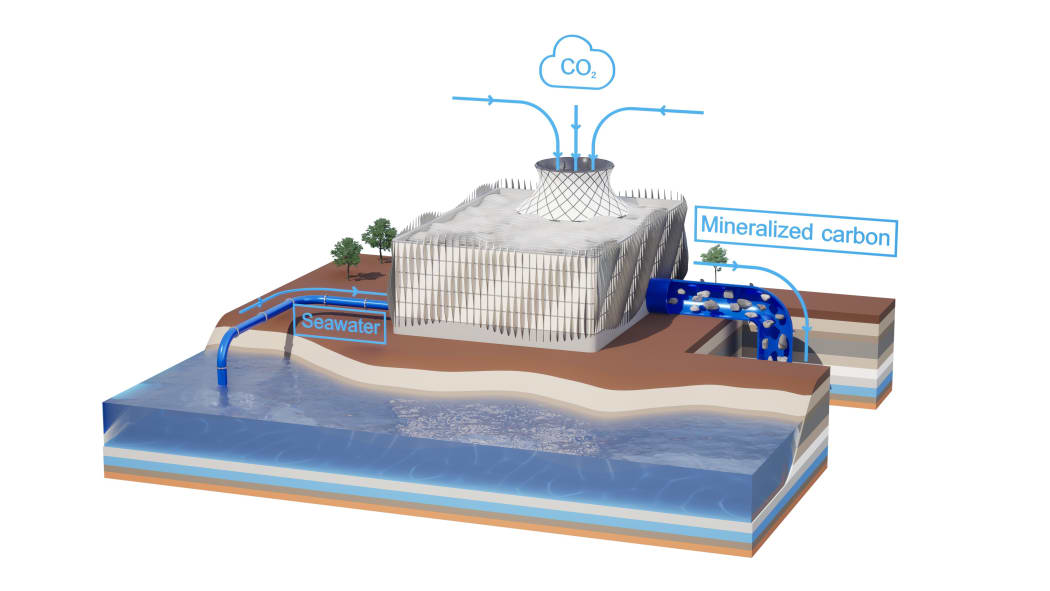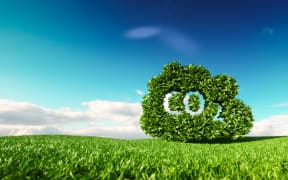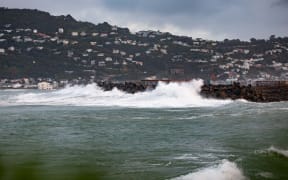
An artist impression of how a potential air carbon capture facility could look for scale at Tiwai Point. Photo: Supplied / Capture6
A company wants to build a facility to suck millions of tonnes of climate pollution out of the air by 2030.
But sceptics say it is prohibitively expensive and we instead need to stop putting pollution up there in the first place.
Direct air capture technology is in its infancy, but it is gaining momentum.
Capture6 co-founder Luke Shors said his firm had developed a simple, scaleable model and that New Zealand could play a cutting-edge role in the industry.
"What's novel is not the equipment itself, it's the sequence of equipment that's used to capture carbon.
"That's why we're really confident in the approach, because this technology is [already being] used in all sorts of industries."
The technology utilises seawater and uses renewable energy to suck CO2 from the air turning it into chalk.
Aotearoa emits about eighty million tonnes of greenhouse gases a year.
Shors said its method, if implemented today, could remove about a million tonnes of CO2 a year for about US$100 a tonne - a scale and cost which puts it up front of the pack internationally.
For now, he is aiming to get a smaller 50,000-tonne facility up and running in Aotearoa sometime next year, but wants to scale up to 5 million tonnes a year by 2030.
"In New Zealand, my goal would be to show the government and the country at large that it is possible to do this, and then hope that that gets brought into the climate approach generally."
New Zealand was a good prospect - there was lots of renewable energy and more solar farms and offshore wind projects in the pipeline, Shors said.
His firm acts basically as removal matchmaker, sponsoring projects and linking investors with companies which would build the actual plants.
It is based in New Zealand, the US and UK, and Shors said it was in joint-venture talks with various parties around the world, including large tech companies which were keen to find a way to offset their emissions..
In New Zealand, he is looking for partners to help it select a site and build the facility, and the firm has had what he calls fruitful conversations with a range of government agencies.
Shors said it was important fast action was taken to reduce emissions, but these kinds of engineering approaches were now a necessary insurance policy.

Diagram of the air carbon capture process. Photo: Supplied
A million tonnes of removal generates a lot of chalk which needs to go somewhere, with options including stashing it in decommissioned offshore oil and gas facilities.
But other huge questions remain for projects like this in New Zealand: resource management hurdles, getting independent verification, not to mention that removal currently is not covered by domestic and international emissions trading schemes.
The technology remains incredibly expensive, with only about 20 removal projects operating internationally sucking up relatively small amounts of emissions.
Nevertheless, a major IPCC report earlier this year says humanity must remove 660 billion tonnes of CO2 from the atmosphere by the end of the century.
Climate scientist and IPCC bureau member Andy Reisinger said the attitude towards the technology had been shifting.
As long as it it was not used as a substitute for reducing gross emissions, then it was a legitimate part of climate action, Reisinger said.
"In principle, should we be looking at this? Absolutely, why wouldn't we as an addition to efforts to reduce our actual gross emissions, and to provide a service globally."
Removal technology could help offset emissions that could not be avoided - for example in the cement-making process, he said.
Jonathan Young, from energy innovation and technology centre Ara Ake, said there was cutting-edge removal research underway in a number of New Zealand universities.
That included at Waikato University where certain rocks were being ground as an experiment in large-scale carbon dioxide capture.
"They're going to be essentially spreading that onto paddocks so it will become part of the soil texture," Young said.
"MIT in the [United States] has been doing this. They say, there's actually potential to store billions of tonnes of CO2 in this manner."
Young, who is the former National Party energy spokesperson, said a direct capture facility takes up about 100 times less surface area than a forest to remove the same amount of CO2.
But Cindy Baxter from Coal Action Network is deeply sceptical.
"The problem with these sort of technologies is that they're usually jumped on by big polluters [including fossil fuel companies] who want to keep emitting and think they can use this to offset their emission."
It made much more sense to stop polluting the atmosphere in the first place, Baxter said.
New Zealand had a propensity to want to rely on offsetting emissions, for example planting masses of trees, but the country needs to just get on with cutting emissions, she said.






